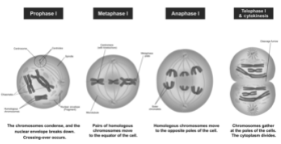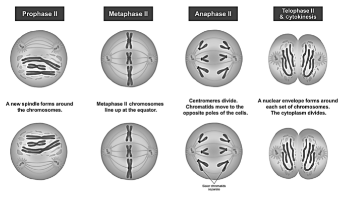Meiosis from the Ancient greek is a reductional division) is a division that takes place within a division. It is a type of cell division of germ cells in sexually reproducing organisms that is used to produce gametes, such as sperm or egg cells, and is unique to these organisms. This procedure involves two rounds of division, which results in four cells with only one copy of each chromosome at the end of it (haploid). Aside from that, genetic material from the paternal and maternal copies of each chromosome is crossed over prior to division, resulting in the creation of new combinations of code on each chromosome after division. Later on, during fertilisation, the haploid cells produced by meiosis from both a male and a female will fuse to form a zygote, which is a cell with two copies of each chromosome for the second time in its history.
Definition
Melia (also known as meiosis) is a type of cell division that occurs in sexually reproducing eukaryotes. It results in the formation of four daughter cells (gametes), each of which has half the number of chromosomes as the original diploid parent cell.
In sexual reproduction, haploid cells divide to form gametes, which by joining with another haploid cell during fertilisation define sexual reproduction and the formation of a new generation of diploid organisms.
Phases of meiosis
Meiosis is divided into stages or phases.
Meiosis is divided into two stages: meiosis I and meiosis II, which are further subdivided into Karyokinesis I and Cytokinesis I and Karyokinesis II and Cytokinesis II, and Karyokinesis I and Cytokinesis II, respectively. In terms of pattern and name, the preparatory steps that lead up to meiosis are identical to those that occur during interphase of the mitotic cell cycle. [10] Generally speaking, the interphase is divided into three phases:
In the first phase of cell growth (G1) : the cell synthesises a large number of proteins, including enzymes and structural proteins that will be required for cell growth. This is a very active phase in which the cell produces a large number of proteins. A single linear molecule of DNA constitutes each chromosome in the G1 state.
A cell’s genetic material is replicated during the synthesis (S) phase, which results in each chromosome duplicating to form two identical sister chromatids that are attached at a centromere. Because the number of centromeres in the cell remains constant, this replication has no effect on the ploidy of the cell. In the light microscope, the identical sister chromatids do not yet appear to have condensed into the densely packed chromosomes that are visible. This will occur during the first prophase of meiosis, during prophase I.
Growth 2 (G2) phase: Meiosis does not have the G2 phase that is seen before mitosis. Meiosis does not have the G2 phase that is seen before mitosis. Meiotic prophase is the phase of the cell cycle that is most similar to the G2 phase of the mitotic cell cycle.
Meiosis I occurs first, followed by meiosis II, and then interphase occurs. Meiosis I divides replicated homologous chromosomes, each of which is still composed of two sister chromatids, into two daughter cells, resulting in a halving of the number of chromosomes in the population. The decoupling of sister chromatids occurs during meiosis II, and the resulting daughter chromosomes are separated and segregated into four daughter cells. The daughter cells produced by meiosis are haploid, meaning that they contain only one copy of each chromosome in the case of diploid organisms. Cells in some species enter a resting phase known as interkinesis between meiosis I and meiosis II, which is characterised by a lack of movement.
In Meiosis I and II, the cell cycle is divided into four stages: the prophase, metaphase, anaphase, and telophase. These stages are analogous in purpose to the mitotic cell cycle’s analogous subphases. As a result, meiosis includes the stages of meiosis I (prophase I, metaphase I, anaphase I, telophase I) and meiosis II (prophase II, metaphase II, anaphase II, telophase II) (prophase II, metaphase II, anaphase II, telophase II).

Meiosis II is the second stage of the cell division process.
Meiosis II is the second meiotic division, and it is characterised by the separation of sister chromatids, a process known as equational segregation. In terms of mechanics, the process is very similar to mitosis, though the genetic outcomes are completely different. From two haploid cells (each of which is made up of two sister chromatids) that were produced in meiosis I come to the production of four identical haploid cells (n chromosomes, 23 in humans) as a result of the meiotic division process. During meiosis II, there are four major steps that must be completed; these are prophase II, metaphase II, anaphase II, and the telophase.
At the end of prophase II, we can see the re-appearance of nucleoli and the re-formation of the nuclear envelope, as well as the shortening and thickening of chromosomes. Centrosomes move to the polar regions of the cell and arrange spindle fibres in preparation for the second meiosis.
Centromeres in metaphase II contain two kinetochores, which attach to spindle fibres from the centrosomes at opposite poles, indicating that the cell is in the process of division.
This is followed by anaphase II, during which the remaining centromeric cohesion, which is no longer protected by Shugoshin, is cleaved, allowing the sister chromatids to segregate from one another. As they move toward opposing poles, the sister chromatids are now referred to as sister chromosomes, according to convention.
The process comes to a close with telophase II, which is similar to telophase I in that it is characterised by the decondensation and lengthening of the chromosomes as well as the disassembly of the spindle at the end of the cell cycle. In the course of the process, nuclear envelopes reform, and cleavage or cell plate formation results in a total of four daughter cells, each of which contains a complete set of chromosomes. Meiosis is now complete, and the result is the formation of four new daughter cells.

Conclusion
Meiosis occurs in eukaryotic life cycles that involve sexual reproduction. It is characterised by a constant cyclical process of meiosis and fertilisation that occurs at regular intervals. This occurs concurrently with the normal mitotic cell division process. The growth of the organism occurs during the intermediate step between the diploid and haploid transitions in multicellular organisms . Germ cells are responsible for the production of gametes at specific stages of the life cycle. Therefore, somatic cells are those that make up the body of the organism and are not involved in the process of gamete production.
 Profile
Profile Settings
Settings Refer your friends
Refer your friends Sign out
Sign out






